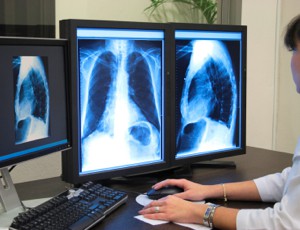Incidence of PICC related upper extremity deep venous thrombosis

To analyze the incidence and its risk factors of peripherally inserted central venous catheter related upper extremity deep venous thrombosis (PICC-UEDVT) in intensive care unit (ICU)” Zhao et al (2017). Abstract: OBJECTIVE: To analyze the incidence and its risk factors of peripherally inserted central venous catheter related upper extremity deep venous thrombosis (PICC-UEDVT) in intensive […]
Ultrasound for central venous catheter positioning and exclusion of pneumothorax

We hypothesize that a combination of transthoracic echocardiography and lung ultrasound is noninferior to chest radiograph when used to accurately assess central venous catheter positioning and screen for pneumothorax” Amir et al (2017). Abstract: Objectives: Although real-time ultrasound guidance during central venous catheter insertion has become a standard of care, postinsertion chest radiograph remains the […]
PISCES trial: RCT design to assess dressing and securement to prevent PICC failure
We designed this RCT to assess the clinical and cost-effectiveness of dressing and securements to prevent PICC failure” Rickard et al (2017). Abstract: INTRODUCTION: Around 30% of peripherally inserted central catheters (PICCs) fail from vascular, infectious or mechanical complications. Patients with cancer are at highest risk, and this increases morbidity, mortality and costs. Effective PICC […]
Nursing contribution to ineffective protection in hemodialysis patients
The aim of this study was to evaluate the clinical validity of indicators of the nursing diagnosis of “ineffective protection” in hemodialysis patients” de Sá Tinôco et al (2017). Abstract: AIMS AND OBJECTIVES: The aim of this study was to evaluate the clinical validity of indicators of the nursing diagnosis of “ineffective protection” in hemodialysis […]
Mnemonic to ensure optimal monitoring and safety of total parenteral nutrition

A guideline-derived mnemonic was developed to systematically and safely manage TPN therapy. The mnemonic combines 7 essential components of TPN use and monitoring: Indications, Allergies, Macro/Micro nutrients, Fluid, Underlying comorbidities, Labs, and Line type” Bohl and Parks (2017). Abstract: OBJECTIVE: To present a guideline-derived mnemonic that provides a systematic monitoring process to increase pharmacists’ confidence […]
Result of balanced fluids for resuscitation in pediatric severe sepsis
To evaluate outcomes in patients receiving balanced fluids for resuscitation in pediatric severe sepsis” Emrath et al (2017). Abstract: Objective: To evaluate outcomes in patients receiving balanced fluids for resuscitation in pediatric severe sepsis. [ctt link=”kd1b5″ template=”1″]ReTweet if useful… Result of balanced fluids for resuscitation in pediatric severe sepsis https://ctt.ec/kd1b5+ @ivteam #ivteam[/ctt] Design: Observational cohort […]
What is the extent of physician and nurse knowledge of safe injection practices?
To inform development, targeting, and penetration of materials from a national injection safety campaign, an evaluation was conducted to assess provider knowledge, attitudes, and practices related to unsafe injection practices” Kossover-Smith et al (2017). Abstract: Background: To inform development, targeting, and penetration of materials from a national injection safety campaign, an evaluation was conducted to […]
Expert vascular access practice and CLABSI reduction

In December 2015, an Oncology service line identified an increase in CLABSI rates specifically stemming from poor care and maintenance and realized a change in practice was necessary” Benjamin et al (2017). Abstract: BACKGROUND: Oncology patients are a distinct population requiring additional needs. Due to their immunocompromised status, central line associated blood stream infection (CLABSI) […]
Strategies to reduce central line-associated bloodstream infections

We describe the successful implementation of evidence based best practices to promote the reduction of CLABSI in this diverse population” Hickox et al (2017). Abstract: BACKGROUND: Central line associated bloodstream infections (CLABSI) are difficult to prevent in the critical care setting as patients often require multiple devices and have vascular access challenges. Our medical center has […]
Central line associated bloodstream infection definition
Central Line Associated Bloodstream Infections (CLABSI) is defined as a laboratory-confirmed bloodstream infection (not related to an infection at another site) where a central line was in place within 48 hour period before the development of bloodstream infection” Haddadin and Regunath (2017). Excerpt: Central Line Associated Bloodstream Infections (CLABSI) is defined as a laboratory-confirmed bloodstream […]
Central venous access via the internal jugular vein

If an ultrasound machine is not immediately available and central venous access via the right jugular vein is required, a simple three-finger technique for insertion of a central venous access line into the right internal jugular vein has proven to be a reliable method for accomplishing this task” Mendenhall and O’Rourke (2017). Excerpt: If an […]
Case study describes malposition of a central venous catheter

This case differs that the catheter itself through the sheath introducer can cause venous injury that may lead to the malposition of CVC particularly through an approach to the left internal jugular vein” Lim et al (2017). Abstract: RATIONALE: The misplacement of central venous catheter (CVC) can occur more often at the left jugular vein […]
Assessment of fluid challenge with 0.9% NaCl compared to balanced crystalloid

We compared the effects of 0.9% NaCl to a less chloride-concentrated fluid, PlasmaLyte® (PL) in targeted fluid resuscitation in a randomized, double-blind controlled study in an experimental model of severe sepsis in rats” Olivier et al (2017). Abstract Background: According to international guidelines, volume expansion with crystalloids is the first-line treatment for hemodynamic management in […]
Impact of femoral haemodialysis catheters on renal transplantation
We share our concerns regarding the prolonged use of femoral haemodialysis catheters and its potential to jeopardise successful renal transplantation” Du Toit et al (2017). Abstract: The ability to identify and address factors that threaten the optimal utilisation of donor organs is quintessential in obtaining satisfactory transplant outcomes. We share our concerns regarding the prolonged […]
Vascular access devices the most reported entry point for staphylococcus aureus bacteraemia

To gain an understanding of the epidemiology of SAB cases and associated risk factors for healthcare and true community onset. Identifying these factors and patient populations most at risk allows focused improvement plans to be developed” Murdoch et al (2017). Abstract: BACKGROUND: Staphylococcus aureus bacteraemia (SAB) is the second most common source of positive blood […]
Regional surveillance system model for central line-associated bloodstream infections

We describe the methods used to define a surveillance model to incorporate into activities aimed at preventing central line-associated bloodstream infections (CLABSI) in non-critical care units (NCCUs) and designed to be implemented at the regional level” Zeneli et al (2017). Abstract: We describe the methods used to define a surveillance model to incorporate into activities […]
Brachial plexus injury associated with subclavian vein cannulation
We documented brachial plexus injury by electromyography and magnetic resonance imaging secondary to needle sticks for central line insertion” Gozubuyuk et al (2017). Abstract: We documented brachial plexus injury by electromyography and magnetic resonance imaging secondary to needle sticks for central line insertion. This type of complication is rare in the literature, as few case […]
Lymphocutaneous fistula secondary to right-sided pheresis catheter placement
We present a case of an iatrogenic lymphocutaneous fistula secondary to placement of a tunneled, large bore (14.5 Fr) right-sided internal jugular vein for plasmapheresis to treat antibody-mediated kidney transplant rejection” Quencer et al (2017). Abstract: We present a case of an iatrogenic lymphocutaneous fistula secondary to placement of a tunneled, large bore (14.5 Fr) […]
Amoxicillin can be administered by continuous infusion using elastomeric pumps

Adequate plasma drug concentrations and favourable clinical outcomes suggest that amoxicillin can be administered by continuous infusion using elastomeric pumps” Arensdorff et al (2017). Abstract BACKGROUND: Elastomeric pumps can be useful for the administration of antibiotics in the outpatient setting. OBJECTIVES: To determine amoxicillin degradation in elastomeric pumps, as well as the effectiveness of amoxicillin […]
Cost-effectiveness analysis of vascular access referral policies

The optimal timing of vascular access referral for patients with chronic kidney disease who may need hemodialysis (HD) is a pressing question in nephrology. Current referral policies have not been rigorously compared with respect to costs and benefits and do not consider patient-specific factors such as age” Shechter et al (2017). Abstract: BACKGROUND: The optimal […]
Medication errors with push dose pressors in the emergency department
Due to prominence of this topic in FOAMed, indications are expanding to include bridge to continuous infusion vasopressors, medication related hypotension during procedural sedation and anaphylaxis” Acquisto et al (2017). Abstract: Utilization of push dose pressors (PDP, low doses of phenylephrine or epinephrine administered IV push) during care of emergency medicine (EM) patients is increasingly […]
Safe use recommendations for “Bolus-Dose” vasopressors in the emergency department

This article discusses the wide range of issues to consider when evaluating the role of bolus-dose vasopressors in the ED and provides recommendations based on current safe medication practices guidelines” Holden et al (2017). Abstract: The use of intermittently administered doses of vasopressors to correct hypotension in the emergency department (ED), commonly referred to as […]
What are the risk factors for persistent candidemia in adult patients?

We investigated the clinical characteristics and risk factors for mortality in adults with persistent candidemia” Kang et al (2017). Abstract: BACKGROUND: We investigated the clinical characteristics and risk factors for mortality in adults with persistent candidemia. [ctt link=”lL9V7″ template=”1″]ReTweet if useful… What are the risk factors for persistent candidemia in adult patients? https://ctt.ec/lL9V7+ @ivteam #ivteam[/ctt] […]
Effect of the use of Buzzy during phlebotomy on blood donors

The objective of this study was to investigate the effect of the use of Buzzy on phlebotomy satisfaction and pain relating to the phlebotomy process in healthy adult blood donors voluntarily donating blood” Yılmaz et al (2017). Abstract: Phlebotomy causes pain and discomfort to adults. The objective of this study was to investigate the effect […]
Sciatic nerve injuries from gluteal intramuscular injection
The purpose of the study was to analyze the cases discussed in High Health Council (HHC) and to determine the solutions for the problems on gluteal intramuscular injection (IMI) applications” Kadioğlu (2017). Abstract: AIM: The purpose of the study was to analyze the cases discussed in High Health Council (HHC) and to determine the solutions […]
OPAT suitable for elderly patients with infective endocarditis

OPAT could be considered an effective alternative for appropriately-selected elderly patients with infective endocarditis” Kortajarena et al (2017). Abstract: OBJECTIVE: The incidence of infective endocarditis is progressively increasing, especially in elderly patients. Outpatient parenteral antibiotic therapy (OPAT) is being an excellent alternative for treatment, but advanced age is one of the relative contraindications. The aim […]
Risk factors of catheter-related bloodstream infection in Japan

In this multicenter, matched case-control study, patients diagnosed with catheter-related bloodstream infection (CRBSI) caused by Bacillus cereus (n = 108) were matched to controls (n = 269)” Kutsuna et al (2017). Abstract: In this multicenter, matched case-control study, patients diagnosed with catheter-related bloodstream infection (CRBSI) caused by Bacillus cereus (n = 108) were matched to controls (n = 269). In the multivariable analysis, […]
Totally implantable IV Treprostinil therapy in pulmonary hypertension

Prostacyclins improve symptoms and survival in pulmonary arterial hypertension (PAH). In response to risks associated with external delivery systems, an implantable intravenous infusion system was developed” Waxman et al (2017). Abstract: BACKGROUND: Prostacyclins improve symptoms and survival in pulmonary arterial hypertension (PAH). In response to risks associated with external delivery systems, an implantable intravenous infusion […]
Ultrasound for placement of central venous catheters in pediatrics

To study the variability of techniques used for vascular access of central venous devices, totally implanted and external tunneled, as well as polling the use of ultrasound by pediatric surgeons in Spain” Sánchez Sánchez et al (2017). Abstract: OBJECTIVES: To study the variability of techniques used for vascular access of central venous devices, totally implanted […]
Review of Tactical Combat Casualty Care includes intraosseous access
Twenty years ago, the original Tactical Combat Casualty Care (TCCC) article was published in this journal” Butler (2017). Abstract BACKGROUND: Twenty years ago, the original Tactical Combat Casualty Care (TCCC) article was published in this journal. Since TCCC is essentially a set of bestpractice prehospital trauma care guidelines customized for use on the battlefield, the […]

